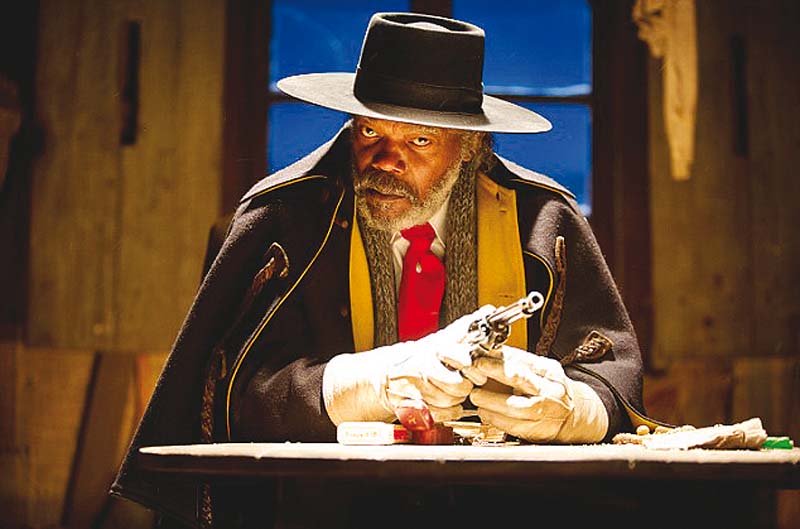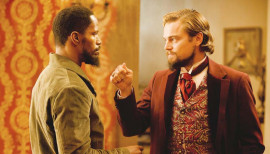
Die-hard Quentin Tarantino fans will find that The Hateful Eight delivers the punch Django Unchained and Inglourious Basterds lacked. Less than die-hard fans, and those to whom films are purely a means of entertainment rather than an art form, will find themselves hard-put in getting around a work that deliberately lacks the mainstream appeal of the director’s previous two projects. In his latest western, Tarantino reaffirms his oft-repeated mantra that he couldn’t give a toss about current cinematic trends.
In what could be the most powerful opening sequence of all his films, we are presented with breathtaking vistas of a frontier – snowy, mountainous Wyoming in the 1870s. Those with a passion for the outdoors will immediately take a liking to the landscape. However, we are quickly reminded by the score – composed by Ennio Morricone especially for this film – that nature can be unforgiving, as can the hearts of men. And as the sinister drumbeat orchestrates the opening credits, it instils in us a sense of foreboding. The visuals and score at the start of the film are a throwback to, and physical manifestation of, the “violent, pitiless landscape” of Sergio Corbucci’s The Great Silence and The Hellbenders. Corbucci’s spaghetti westerns were partly the inspiration behind Tarantino’s dabbling in the genre. The Great Silence, too, is set in snow-covered mountainous regions. It disconcerts the audience by serving a dose of the unexpected. Similarly, The Hateful Eight tweaks the nose of the audience’s expectations.
Some reviews have described the film as playing out like an Agatha Christie mystery. But this is merely the tip of the iceberg. Any aspirations to a classic whodunit are soon overturned as the boundaries of a conventional plotline are redefined, taking the audience on an emotional rollercoaster. When standard practices and expectations are discarded, anything is possible. Fans critical of Tarantino’s foray into genre pieces may be pleased to discover that this film does not by any means shy away from overstepping genre boundaries. Therein lies its unpredictability. It is first and foremost a western, but at the same time, many other things. It has elements of a historical piece, slasher film, slapstick comedy, dark comedy, horror, surrealist piece, a musical, and a strangeness and absurdity that cannot be placed under any particular category.
A longer wait for ‘The Hateful Eight’
Tarantino once explained that although the spaghetti westerns of Sergio Corbucci weren’t meant to have underlying themes, or subtextual connotations, he nevertheless liked to dissect them in such a manner whereby he could draw his own in-depth interpretations and critical analyses. Perhaps The Hateful Eight is a result of this experimentation. The characters certainly aren’t without their depth, and the lines between good and bad are blurred. Every character evokes empathy and hate. We are left to form our own opinions.
We come across sensibilities rarely found in films today. We learn to appreciate that the hillbilly son of a renegade army leader who fought for a lost cause after the defeat of the Confederacy, can have integrity and honour – but who may in conventional cinema be no more than a two dimensional villain. At the same time, we see the dark side of an African-American Union major. Civil War sensitivities run deep. There is unusual attention to detail, such as subtle facial expressions, eye movement and body language (one of the main reasons why Tarantino insisted on shooting the drama in 70mm). And there is something very odd about the accent of Tim Roth’s Oswaldo Mobray… On a second viewing, these details come together to provide us with a greater understanding of things.
Tarantino sued over ‘Django Unchained’
The general feel and appearance of Minnie’s Haberdashery, a stagecoach stopover where all the characters are stranded, makes one wonder whether the roots of inspiration behind this setting can be traced to the sheriff’s office-cum-jail in Rio Bravo, one of Tarantino’s favourite ‘hangout’ films.
The dialogue has a rhythmic quality to it that can at times serve as a guilty pleasure. Certain sentence structures and phrases are deliberately borrowed from Django Unchained, for dramatic effect. And there are moments when Jackson is the funniest he has ever been in a Tarantino film (or in any film for that matter). As the director’s eighth offering might be one of his most eccentric yet, we remain grateful for the Hateful.
Verdict: A controversial work that will undoubtedly draw a mixed response. Nonetheless, it is an interesting and unusual cinematic experience, complimented by a great score

Published in The Express Tribune, January 26th, 2016.
Like Life & Style on Facebook, follow @ETLifeandStyle on Twitter for the latest in fashion, gossip and entertainment.




































COMMENTS (1)
Comments are moderated and generally will be posted if they are on-topic and not abusive.
For more information, please see our Comments FAQ